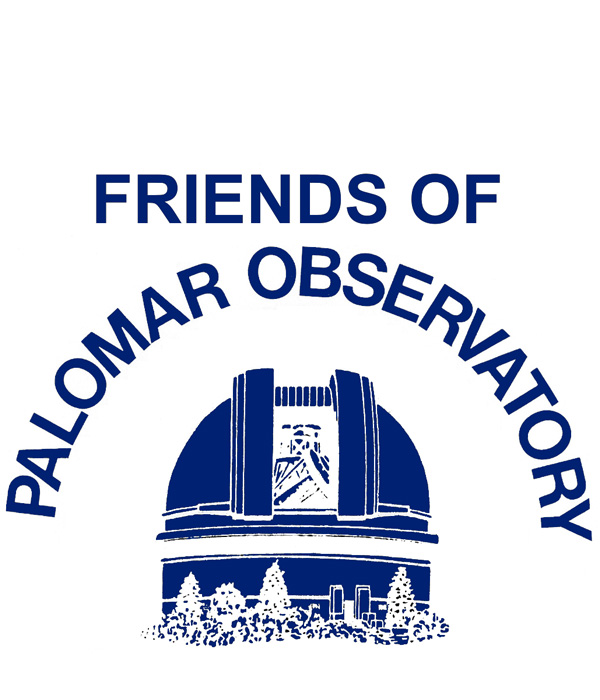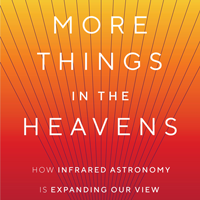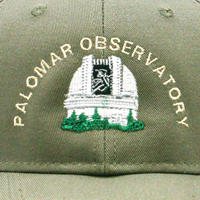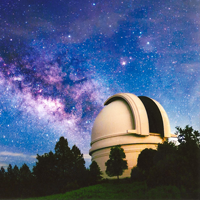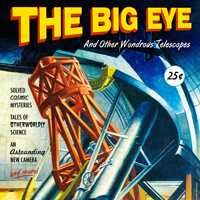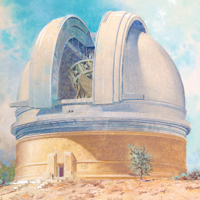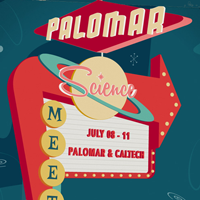Friends of Palomar Observatory Website
Upcoming Events
Greenway Talks schedule
The Newsletter of the Friends of Palomar Observatory, Vol. 16 No. 2 – October 2021
Dome Construction Digital Exhibit
By Andy Boden and Annie Mejía
Hale dome slideshow. Click to start. Use < or > to reverse or advance one slide, or the progress dots to jump slides (this pauses the slideshow). Click any image to enlarge and on some captions for further context. The slideshow will pause for videos. Open in a new tab for enhanced context.
Continuing a thread from our spring newsletter, we report here on a second observatory-themed digital exhibit that we have developed: a pictorial history of the Hale dome. Having spent much of our professional careers in the Palomar community (and having read Perfect Machine multiple times each) we were confident in advance of being well-versed in the dome’s origin story…
All Palomar enthusiasts know the basics: the Hale dome was from conception Russell Porter’s centerpiece for the observatory compound, the telescope base and dome have independent foundations, the basic dimensions of the structure, and how public interest in the telescope project guaranteed dome progress was often in the press. But having collaborated on this exhibit we came away from the experience struck by two themes we hadn’t really understood before:
- The all-too-fluid process that led to the dome design and construction. Annie discovered design drawings from as late as three months before groundbreaking (June 1936) that were significantly different (e.g. we infer without the monocoque dome concept contributed by von Karman, and of a slightly different diameter) than the as-built dome we see today. And as late as November 1936 (well after the telescope and dome steel substructures were in place) Porter was still finalizing dome cosmetic details and reviewing the same with the Observatory Council (the governing body for observatory development and operation). We must have spent an hour debating the possibility that some or all of the records could be misdated...but in the end we concluded the dates were accurate and the record tells the story of a remarkably aggressive dome development approach.
- The very human element to the observatory site development in general and dome development in particular. In curating the many photographs we have from the construction period we included some that capture the humanity of the development effort in ways that engaged our visual imaginations. But we found many more photographs that we couldn’t include but that have remained with us—depicting the men and women and families that made the observatory their home and its development the focus of their energies. As we wrote for the exhibit context narrative:
Of course there were other fun things we learned along the way (please do ask sometime), but in the end we feel working on this exhibit gave us a much deeper appreciation of what the dome construction experience must have been like. Separately we should acknowledge the many important suggestions Steve Flanders made in exhibit captions and content; and just how valuable the Caltech Archives’s online catalog has been in this and other exhibit development—we are so fortunate to enjoy the friendship and collaboration of Loma and Peter and Joy in Caltech Library/Archives, and you will be hearing more about our work together soon.
We hope you enjoy viewing this exhibit as much as we enjoyed researching and creating it.
Hale Observations in Modern Astrophysics Part I: The SAGA Survey
By Andy Boden
We like to say that the venerable Hale Telescope still works at the “cutting edge” of modern astronomy. For our Friends newsletter we thought we would substantiate that statement a little and describe some of the projects using the Hale in a modern context. In this first installment I will talk about an ambitious project known as the SAGA Survey: Satellites Around Galactic Analogs. This project is led by Marla Geha of Yale, Yao-Yuan Mao of Rutgers, and Risa Wechsler of Stanford.

Milky Way Subgroup: this rendering shows the relative geometry of the Milky Way galaxy and several prominent satellite galaxies. The physical scale of the rendering is roughly 200 kpc or 660 kly across. (J. Bullock/M. Geha/R.Powell)
First to put SAGA in context I’ll talk a little about galaxies. In a modern view of galaxy formation, “largeish” (i.e. massive) galaxies like the Milky Way are assembled by accumulating a significant fraction of their mass from smaller galaxies over time. The Milky Way we see today is the result of billions of years of this assembly/assimilation process, and the larger system includes not just the main galaxy, but numerous “satellite” galaxies that orbit the Milky Way. Many of these satellite galaxies will be familiar to astronomy enthusiasts, such as the Large and Small Magellanic Clouds, and some will be less familiar such as the Ursa Major II Dwarf (see a list of known Milky Way satellite galaxies in Wikipedia).
For obvious reasons our Milky Way and its satellite galaxies (the “Milky Way subgroup”) is the best studied galaxy system, and its properties generally agree reasonably well with our current theories of the universe’s large scale structure (so-called “ΛCDM cosmology”—the CDM refers to the role played by cold dark matter in the universe). But there are simulations that suggest potential discrepancies between the predictions of ΛCDM and observed Milky Way subgroup properties. The most prominent of these is the “too-big-to-fail” problem: ΛCDM and some models of galaxy formation predict more and more massive satellite galaxies than are seen in the Milky Way subgroup.



Three nearby SAGA host galaxies, top to bottom: NGC 1015, NGC 4158, and NGC 6181. Several SAGA host galaxies are familiar "deep sky" objects popular with amateur astronomers. (M. Geha)
Apparent discrepancies between the Milky Way subgroup observed properties and theoretical predictions raise an important question: just how typical or unusual is the Milky Way subgroup in the larger population of galaxy systems? It is just this question that the SAGA Survey is designed to answer. As Marla Geha put it back in 2017: “We use the Milky Way and its surroundings to study absolutely everything. Hundreds of studies come out every year about dark matter, cosmology, star formation, and galaxy formation, using the Milky Way as a guide. But it’s possible that the Milky Way is an outlier.”
To address the galaxy system demographics questions the SAGA Survey has selected 100 suitable “host” galaxies for system study. In SAGA’s most recent published results (Paper II—Mao et al 2021; see also Paper I—Geha et al 2017) 36 systems including a set of 127 confirmed satellite galaxies are spectroscopically observed. Many of the SAGA host galaxies are bright and probably familiar to amateur astronomers (e.g. NGC 1015, NGC 4158, and NGC 6181—depicted). The Hale Telescope and the Double Spectrograph was used (among other telescopes and external datasets) to measure redshift, confirm host association, and assess star formation history in the satellite galaxies. In particular Hale data played a key role when other initial data sets were assessed as having insufficient quality to allow reliable results—Yale has invested 26 Hale nights in the project over the past two years. Supplementary imaging datasets (e.g. the Sloan Digital Sky Survey) were used to infer satellite galaxy luminosity, colors, and physical separation from the associated host among other properties.
So what are the bottom line conclusions from SAGA? Well, first that it is not yet complete—only about ⅓ of the full sample of hosts are fully analyzed and published. Both observational and data analysis work remains. But second, the early trends in SAGA results suggest that in fact most galaxies/halo systems do agree with the broad predictions of ΛCDM, and the Milky Way subgroup may well be atypical of peer galaxy systems in the local universe. Whether ΛCDM is a reliable paradigm of structure formation or is to be replaced by a model that better matches observed large scale structure and galaxy system properties remains an open question. Either way, when the SAGA Survey is complete it will provide a much richer understanding of the properties of galaxy systems in general and where our particular galaxy home is in that space. And again the Hale Telescope will have made important contributions to humankind’s understanding of the observable universe. But what else is new?
Thanks to “Team SAGA” for their help in developing this article.
References
- The SAGA Survey website.
- The SAGA Survey e-poster.
- J. Shelton (September 20, 2017) Is the Milky Way an ‘Outlier’ Galaxy? Studying its ‘Siblings’ for Clues, Yale News.
- M. Boylan-Kolchin, J.S. Bullock, & M. Kaplinghat (July 2011) Too Big to Fail? The Puzzling Darkness of Massive Milky Way Subhaloes. MNRAS Letters, 415(1), L40.
- D.H. Weinberg et al (October 6, 2015) Cold Dark Matter: Controversies on Small Scales. PNAS, 112(40), 12249.
- J.S. Bullock & M. Boylan-Kolchin (August 2017) Small-Scale Challenges to the ΛCDM Paradigm. ARA&A, 55, 343.
- M. Geha et al (September 2017) The SAGA Survey: I. Satellite Galaxy Populations Around Eight Milky Way Analogs. ApJ, 847, 4.
- Y. Mao et al (February 2021) The SAGA Survey. II. Building a Statistical Sample of Satellite Systems Around Milky Way-Like Galaxies. ApJ, 907, 85.
Hale Primary Mirror Recoating in Mid-November 2021
By Andy Boden
Video about the Hale's 200-inch primary mirror and its maintenance. Duration: 3:06 minutes. (Palomar/Caltech)
Annotated (via subtitles) video of the aluminum recoating process for the 200-inch mirror. Duration: 2:20 minutes. (Palomar/Caltech)
The Hale Telescope has roughly 530 tons of moving mass in the telescope structure and 1000 tons of moving mass in the dome above it. I am fond of remarking that all of these impressive structures, mechanical engineering, and control is aimed at getting about 5 g of aluminum to the right place and time to collect and direct the right incident starlight into our instruments. To make sure the collection process is efficient, our aluminum mirror coatings must remain relatively clean and uniform—something that has been challenging for us under pandemic conditions.
Typically we recoat the up-facing Hale primary once every two to three years, and with routine maintenance (e.g. periodic CO2 dusting and water—yes water—washing) that is sufficient to maintain reasonable mirror “reflectivity” throughout our wavelength range of interest (call it 300 nm – 2.5 μm). But under pandemic conditions we were forced to forgo much of this routine mirror maintenance program, and the primary reflectivity has significantly degraded since its last recoating in Fall 2018. Present reflectivities near the blue end of the spectrum (~ 400 nm) have degraded below 60%, and the Hale’s productivity is adversely impacted.
Because recoating is an involved, collaborative process, we did consciously assess and forego primary recoating last fall in the interests of staff safety (i.e. before COVID-19 vaccines were readily available). But the need to improve mirror reflectivity has become pressing, and once again our excellent observatory staff have risen to the challenge of reimagining recoating processes to keep everyone safe. Therefore I am happy to report that we will be moving forward with the scheduled Hale primary recoating in mid November.
I seem to say this a lot: the heart of our Palomar Observatory community is our observatory staff, and their dedication to reimagining our operations processes during these challenging times is something that we all appreciate, and I know I will never forget. On behalf of all of us in the Palomar community, I’ll take this opportunity to thank them once again for their dedication in maintaining sky access for us all.
Questions? We've answered many common visiting, media, and academic questions in our public FAQ page.
Please share your feedback on this page at the
COO Feedback portal.
Big Eye 16-2
Last updated: 8 October 2021 AFB/ACM
